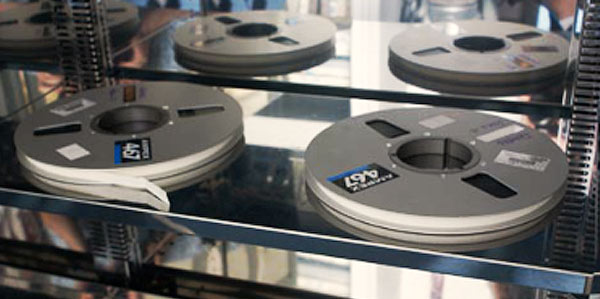Playing Archived Masters
The production process of bringing a new “high-resolution music” product to market begins with determining whether the project has merit…will it sell? As I learned while visiting Battery Studios in Manhattan, the label people see the release of a legacy album as much more than a high-res music piece. They want to know that the album can attract a diverse audience, which includes the high-res version, a collector’s version with lots of bonus materials, a CD, and deliveries to the streaming services. They have to depend on a variety of markets to make a profit. The projects that were in the pipeline at Sony’s Legacy Recordings were Roger Waters and Elvis…they should do fine with both of those.
Regardless of how battered the boxes that contain the chosen master, the analog reels of tape inside are what count. Most master tapes are 1/4″ wide and have stereo tracks (monophonic recordings on 1/4″ analog tape actually have better dynamic range…the wider the track the better the fidelity), which are easily playable on reel-to-reel tape decks. Thankfully, there are a lot of 2-track 1/4″ decks still in operation. I have my Nagra IV-S with the large reel QGB adaptor strapped to the back and an Ampex 440-C. Professional studios may have models from Otari, Studer, Ampex, and Sony. These vary in quality and must be carefully maintained and aligned for optimal transfers. All decks are not created equal and many transfers are done on less then optimal equipment. Of course, the transfer from analog to digital is the single most important stage in the release of a high-res music product.
It is not uncommon to run into difficulties when transferring analog tapes. Depending on the type of tape and the environment (temperature and humidity) that it was stored in, many tapes have to be “baked” in a convection oven in order to get a successful transfer. The lubricants that exist in the tape evaporate over time. When these tapes are played back, the lack of lubrication causes the tapes to shutter and vibrate against the heads resulting in an audible high-frequency noise. Baking the tapes brings any remaining lubricant to the surface of the tape and provides the best chance for a successful transfer. In some cases, transfers cannot be accomplished. It’s interesting that some of the worse tapes are some of the most recent. Older tapes don’t exhibit the problem nearly as much.
What about other recording formats? My own multitrack masters are stored on Exabyte 8mm tapes…a format that was popular 15 years ago but has since been retired. I recorded my projects on a Euphonix R-1 multitrack machine that used multiple 9 gig hard drives to store 24-36 tracks of 96 kHz/24-bit PCM audio (this was 15 years ago when hard drive space was expensive and much smaller than it is today). To back up the hard drives, Euphonix sold a double Exabyte rack unit. A single 9-gigabyte drive would be transferred to a single archival tape…over several hours.
If artists used the R-1 system 15 years ago, their archives are in a format that is rare. I have been called upon to restore Exabyte tapes of some major artists over the years. The process is to get the data off of the archival tapes, transfer the audio tracks (in realtime) to a Pro Tools system, and then back those digital files up. Currently, backups can be placed on hard drives, solid-state drives, USB memory sticks, or in the cloud.
Other formats present other problems…there are DATs, Sony F1 Beta tapes, 1630 UMatic tapes, ADATs, and 8mm masters and more. It turns out that analog tapes are a very robust format to store audio masters for the long term.


Analog tapes are surprisingly robust, but nothing beats a 78 RPM platter. 😉 http://www.npr.org/templates/story/story.php?storyId=1216161
But sound quality counts too, right?
Nice April Fool’s joke.
For those interested in preserving their audio collections, the Association for Recorded Sound Collections (ARSC), the Council on Library and Information Resources (CLIR) and the National Recording Preservation Board of the Library of Congress commissioned a guide to audio preservation. While most of the information in this guide will not be new for most readers of these posts, it is a good summary. The following warning about DAT got my attention, I think I need to get more serious about making sure I have copies of all my DATs from the 90s.
“The pure iron pigments used in the magnetic layer of DATs are susceptible to oxidation (rust). Binder hydrolysis
in the polyester urethane binder has proven to be a prevalent issue with many DATs, causing complete loss of
information. The high speeds produced by the rotating heads passing by the moving tape exacerbate damage
to the information layer. After the error threshold is crossed, the information is irretrievable. These factors
combine to make DATs a very high-risk format, recommended for immediate digital preservation by trained
preservation engineers with high-quality equipment (Eldridge 2010).”
http://www.clir.org/pubs/reports/pub164